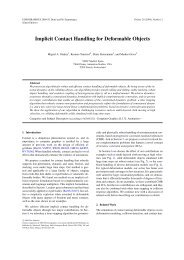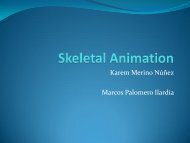Perceiving affordances in virtual reality: Influence of person ... - GMRV
Perceiving affordances in virtual reality: Influence of person ... - GMRV
Perceiving affordances in virtual reality: Influence of person ... - GMRV
You also want an ePaper? Increase the reach of your titles
YUMPU automatically turns print PDFs into web optimized ePapers that Google loves.
1 Introduction<br />
In order to successfully engage <strong>in</strong> an <strong>in</strong>tended behavior, for example, to negotiate<br />
a cluttered environment, a perceiver–actor must be able to perceive the different<br />
action possibilities <strong>of</strong>fered by this environment. Particular <strong>in</strong>formation must be<br />
available for the perceiver-actor to determ<strong>in</strong>e whether an action is possible or<br />
not. Such possibilities for action are known as <strong>affordances</strong> (Gibson 1979). In this<br />
context, a horizontal and rigid surface would afford walk-ability, a large aperture<br />
would afford pass-ability, and so forth. Thus, the environment is full <strong>of</strong> th<strong>in</strong>gs<br />
that have different <strong>affordances</strong> for the organism act<strong>in</strong>g <strong>in</strong> it. For the psychologist<br />
J. J. Gibson, the affordance is directly perceivable by the organism because<br />
there is <strong>in</strong>formation <strong>in</strong> the environment that uniquely specifies that affordance<br />
for this organism (Michaels and Carello 1981). In other words, Gibson’s<br />
<strong>affordances</strong> <strong>in</strong>troduce the idea <strong>of</strong> the actor-environment mutuality; the actor<br />
and the environment make an <strong>in</strong>separable pair. This idea was different from the<br />
contemporary view <strong>of</strong> the time that the mean<strong>in</strong>g <strong>of</strong> objects was created <strong>in</strong>ternally<br />
with further “mental calculation” <strong>of</strong> the otherwise mean<strong>in</strong>gless perceptual data.<br />
Indeed, Gibson's work was focussed on direct perception, a form <strong>of</strong> perception<br />
that does not require mediation or <strong>in</strong>ternal process<strong>in</strong>g by an actor (see Jones 2003;<br />
Chemero 2003).<br />
The concept <strong>of</strong> <strong>affordances</strong> and J. J. Gibson’s view <strong>of</strong> study<strong>in</strong>g organism and<br />
environment together as a system has been one <strong>of</strong> found<strong>in</strong>g pillars <strong>of</strong> ecological<br />
psychology. Although <strong>in</strong>troduced <strong>in</strong> psychology, the concept <strong>in</strong>fluenced studies<br />
<strong>in</strong> other fields as autonomous robotics (Sah<strong>in</strong> et al. 2007; Ugur and Sah<strong>in</strong> 2010;<br />
Ugur et al. 2011; Fitzpatrick et al. 2003) and human–computer <strong>in</strong>teraction<br />
(Gross et al. 2005; Norman 1988, 1999; McGrenere and Ho 2000). Regard<strong>in</strong>g<br />
the human-computer <strong>in</strong>teraction field, design pr<strong>in</strong>ciples have largely focused<br />
on static representations and thus have yet to fully <strong>in</strong>corporate theories <strong>of</strong><br />
perception appropriate for the dynamic multimodal <strong>in</strong>teractions <strong>in</strong>herent to<br />
<strong>virtual</strong> environment (VE) <strong>in</strong>teraction. In other words, there is a need to <strong>in</strong>tegrate a<br />
comprehensive theory <strong>of</strong> perception <strong>in</strong>to VE design. Theories <strong>of</strong> direct perception,<br />
<strong>in</strong> particular affordance theory, may prove particularly relevant to VE system<br />
design because affordance theory provides an explanation <strong>of</strong> the <strong>in</strong>teraction <strong>of</strong> an<br />
organism with its environment (see Gross 2004, 2005).<br />
2





